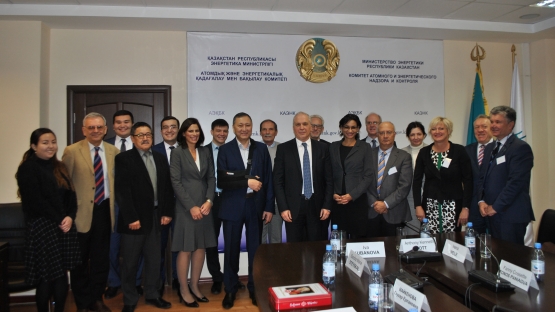The IAEA has revised guidelines to help Member States benefit from its Integrated Nuclear Infrastructure Review (INIR) in a more structured way. The INIR service is available to both countries that wish to introduce nuclear power, also known as newcomers, and those that are expanding their nuclear power programme. It is a valuable tool to ensure that the infrastructure required for the safe, secure and sustainable use of nuclear power is developed and implemented in a responsible and orderly manner.
Guidelines for Preparing and Conducting an Integrated Nuclear Infrastructure Review (INIR), published as IAEA Services Series No. 34, documents all steps of this holistic peer review service. The INIR process as such is not new, as the Agency looks back at eight years of experience and lessons learned from 22 INIR missions to 16 Member States. The document draws on feedback from all embarking countries which have hosted INIR missions since 2009, as well as input from international experts and IAEA staff, and thus optimizes the implementation of the process.
“We have consolidated the INIR service into four clearly defined steps,” explained Milko Kovachev, who heads the IAEA’s Nuclear Infrastructure Development Section. “A request from a Member State for this service signifies the commitment to all steps.” They are:
Step 1: Assessment of the Self-Evaluation Report (SER) prepared by the Member State requesting the service; the SER is to be based on the IAEA document Evaluation of the Status of National Infrastructure Development (Rev.1). The IAEA will review the country’s assessment of its nuclear infrastructure and may organize a SER support mission, if required.
Step 2: Conduct of a pre-INIR mission, where the INIR process will be presented and discussed with the Member State and terms of reference for the main INIR mission will be agreed upon.
Step 3: Conduct of the main INIR mission, where the status of the nuclear power infrastructure will be reviewed by a team of IAEA staff and external experts, based on the SER, supporting documents and interviews with key counterparts. The result will be the main INIR mission report with recommendations and suggestions in areas requiring additional work. Good practices will be recognized.
Step 4: Follow-up INIR mission, to assess the implementation of recommendations and suggestions provided during the main mission. The timing, to be agreed with the Member State, would be 18–30 months after the main mission.
Increased transparency
Several Member States that have hosted INIR missions have made their reports available to the public and on the IAEA website, most recently Ghana and Kazakhstan. Earlier, Belarus, Jordan, Poland and the United Arab Emirates have made their reports publicly available.
“The IAEA encourages this approach, since transparency and openness build credibility and enhance public trust,” said Milko Kovachev. This also minimizes risks related to stakeholders’ perceptions and any resulting opposition to nuclear power that can result from misunderstanding and lack of knowledge. “According to the revised guidelines, the IAEA will publish the INIR mission report 90 days after delivery to the Member State on its website, unless the country requests us not to do so.”
The INIR service is based on the IAEA Milestones approach, a methodology developed by the IAEA in response to growing demand by embarking countries for advice and assistance. It helps Member States to understand the commitments and obligations associated with developing a nuclear power programme. Countries that already have nuclear power can also assess their preparedness for expansion. This approach is set out in the IAEA publication Milestones in the Development of a National Infrastructure for Nuclear Power.







